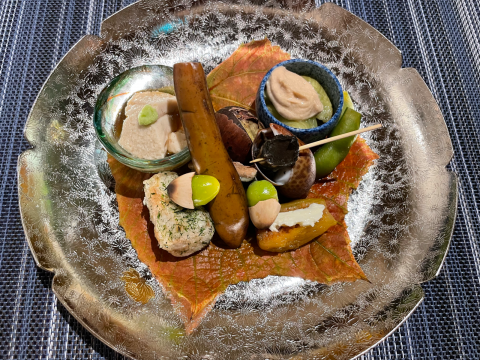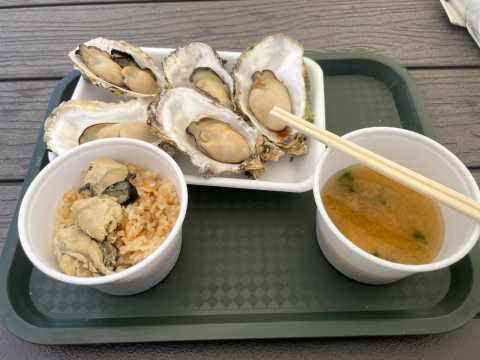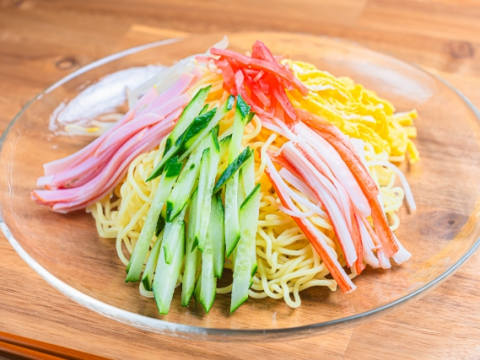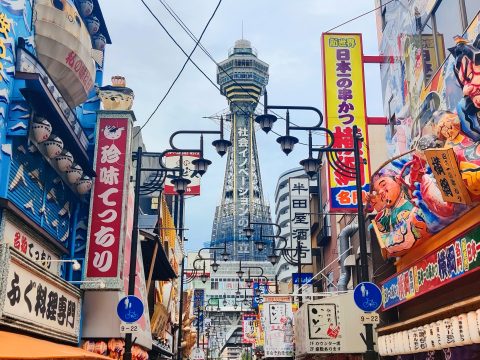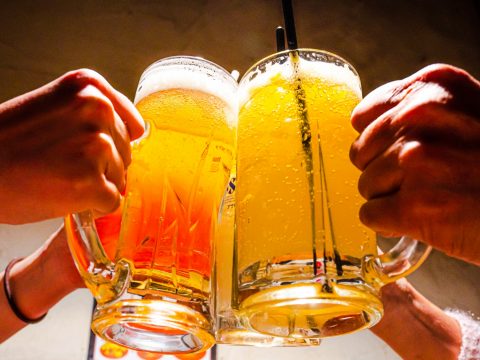New Year’s Food
JAPANESE FOODS
11.01.2024
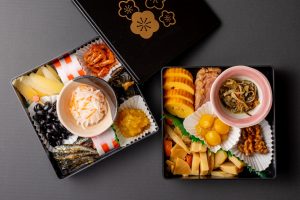
What is typically eaten in Japan at the end and the beginning of the year? Many traditions still persist in Japan when it comes to food. Let’s take a look at them!
Toshikoshi Soba
This dish is typically eaten on the last day of the year, also known as Ōmisoka. As a tradition, it is usually served with soba noodles with a hot dashi broth. Therefore, you can make it your own way and add your favorite ingredients to it.

We decided to add toppings to make the dish even better: shrimp tempura, nameko (it’s a type of mushroom), and daikon oroshi (Japanese Grated Radish). You may be wondering why most of Japan’s population eats this dish on New Year’s Eve. Eating toshikoshi soba, symbolizes the desire to leave behind the arduous past and start a peaceful and fulfilling year, gaining strength every time you slurp up the soba noodles.
Osechi
Osechi ryori is eaten at the beginning of the year, also known as Oshogatsu. Although osechi have been greatly modernized, their true origin is in the Heian period (794–1185).
It is served on special boxes called jūbako (重箱), which resemble bentō boxes. Each dish that makes up the osechi has a different meaning to celebrate the arrival of the new year. Nowadays, some brands or shops that make osechi includes their own original elaborations, so you will be able to try different flavors and dishes every year. Many families decide to rest during the first days of the year, so they do not cook either. Eating osechi is a way to avoid cooking, as it usually lasts a whole day (or more), and there is no need to heat it.

Different countries, different traditions
Of course there are more dishes that are eaten in Japan in that season of the year. However, these are the ones I got the chance to try this New Year, so I wanted to introduce them to you. The thing that has caught more my attention is not the food, but the way many families spend the beginning of the year in Japan.
Actually, I didn’t know about it, and it is completely different from how it is spent in my country. Most of them just eat and lay down on the kotatsu (if they have it). This surprised me a lot, and I thought I was not able to spend three days like that. But in the end, you can rest a lot and disconnect from work and your daily life.


Carmen Alvarez
Carmen grew up in a city in southern Spain. After graduating from university, she decided to move to Tokyo to study Japanese. She enjoys walking the streets of Japan, discovering new places and trying different Japanese dishes.
Read previous articles by the writer
Read latest articles
KEYWORDS
- # PICKPICK
- # Resume
- # alcohol
- # Rice
- # Soup
- # winter food
- # Fast Food
- # seafood
- # spicy foods
- # raw food
- # fermented food
- # Transportation
- # MEAT
- # Edo culture
- # suits
- # clothing
- # drink
- # fish
- # seasoning
- # Japanese New Years Foods
- # Toshikoshi soba
- # Osechi Ryori
- # Ozoni
- # Christmas
- # Japanese fusion pasta
- # Wafu Pasta
- # Japanese Hot Pot
- # なべ
- # 鍋
- # Miyazaki
- # Chicken Nanban
- # Karamen
- # Autumn Wagashi
- # Mushi-yokan
- # Imo-yokan
- # Japanese Autumn Fruits
- # Autumn
- # Vending Machine
- # fall
- # dango
- # Chestnut rice
- # saury
- # Mushroom
- # Rice vinegar
- # Japanese condiments
- # 調味料
- # Sake
- # Mirin
- # Soy sauce
- # Japanese Noodles
- # Udon
- # Ramen
- # Yakisoba
- # Soba
- # Japanese Seaweed
- # 海藻
- # かいそう
- # Payslip
- # Training
- # Japanese summer foods
- # 和菓子
- # Wagashi
- # ryokucha
- # 夏
- # 飲み物
- # Ramune
- # ラムネ
- # Pokari Sweat
- # ポカリスエット
- # Calpis
- # カルピス
- # Mugicha
- # ume
- # 梅
- # うめ
- # umeshu
- # job hunting
- # tofu
- # Recruitment in Japan
- # miso
- # Japanese cuisine
- # Yellowtail and bonito
- # Children’s Day
- # Kashiwa Mochi
- # Chimaki
- # fruits
- # Kusamochi
- # Types of Agriculture in Japan
- # bread
- # パン
- # パン屋さん
- # japanese bread
- # shokupan
- # meal blead
- # anko bread
- # 桜
- # さくら
- # cherry blossom
- # visa
- # hanami
- # omotenashi
- # sakura
- # おもてなし
- # Japanese hospitality
- # oshibori
- # wet hand towel
- # hand towel
- # restaurant
- # Commuting in Japan
- # Women-only cars
- # Exit gate
- # japanese train
- # train
- # valentine
- # Japanese sweets
- # 朝食
- # Japanese Breakfast
- # Breakfast
- # Japanese
- # 日本
- # healthy
- # persimmons
- # hoshigaki
- # HR
- # work in Japan
- # jinji ido
- # corporate systems
- # Japanese work culture
- # bento
- # ekiben
- # shinkansen
- # omiyage
- # train station
- # Japanese culture
- # work culture
- # mentaiko
- # umeboshi
- # Japanese snacks
- # potato chips
- # Japanese potato chips
- # Japanese writing
- # seaweed
- # konbu
- # ocean foods
- # shio konbu
- # dashi
- # miso soup
- # food processing
- # pear
- # nashi
- # sweet potato
- # japanese sweet potato
- # stingray
- # satsuma imo
- # food value chain
- # homecooking
- # agriculture
- # Japanese homecooking
- # farming
- # nikujaga
- # shojin ryori
- # meat and potatoes
- # traditional foods
- # comfort food
- # buddhist food
- # manufacturing
- # factory
- # eihire
- # vegetarian
- # food and beverage
- # izakaya
- # yatai
- # japanese festival
- # taiyaki
- # matsuri
- # summer
- # Ikayaki
- # smart agriculture
- # shaved ice
- # kakigori
- # かき氷
- # summer dessert
- # Japan
- # Japanese foods
- # dessert
- # fruit
- # matcha
- # icecream
- # Pikcup
- # Pikc up
- # Pcikup
- # skilled labor visa
- # working visa japan
- # Dineer Table in Japan
- # Japanese manner
- # Japanese food
- # Japanese Table Manner
- # Chopsticks
- # Japanese traffic signs
- # traffic information
- # road rules in Japan
- # chocolate
- # green tea
- # Osaka
- # Work Japan
- # Japanese company
- # ikura
- # sushi
- # nigiri
- # wasabi
- # PCIK
- # PICK UP
- # PICK
- # PICKUP


